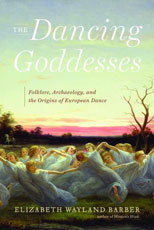"Dance formed and still forms a sort of glue holding people and life together, bonding communities. It mediated life's joy, pain, hopes and fears, love, hate, tedium and tingling expectation. Dance also marked off ritual time and space, served to anesthetize fatigue and heal sickness, and even sought to produce life. Dance was not an 'art form' but the essence of life itself," writes Elizabeth Wayland Barber, author of six books exploring the connections between archaeology and linguistics. She grew up participating in international folk dancing groups and has always had a passion for this activity. Visit her website where she posts dance related research at www.elizabethwayladnbarber.com.
Barber combines her extensive knowledge of archaeology, linguistics, and folklore in this erudite overview of the dancing goddesses (female spirits) who were called upon as sources of fertility in medieval times, during the Roman and Greek eras, and to the communal get-togethers of the first farmers in Europe. With energy and an impressive command of this mix of materials, the author is able to regale us with accounts of the swan maidens, mermaids, and tree spirits of eastern European folklore; the dances of the "willies," songs sung to the birches as the first trees to bud in order to bring in the spring; the ritual of leaf-clad orphans to bring an end to rain; the bride dancing for fertility in "The Frog Princess" fairy tale; and much more.
In a standout section titled "Gotta Dance," Barber hits high stride with a look at cognitive science's exploration of human dancing, trance-dancing, and fire walking, along with a meditation on reconstructing the dances from long ago. Two of the opponents of folk dancing have been Christian clergy and Eastern European Communists who both had nothing but disdain for the superstition connected with festivals and rituals.
In these times when little girls around the world are still seen as inferior in every way to boys, it seems imperative to find a modern equivalent for the girl souls "dancing in the fields and swinging from the trees, bringing promise of the next round of life."
